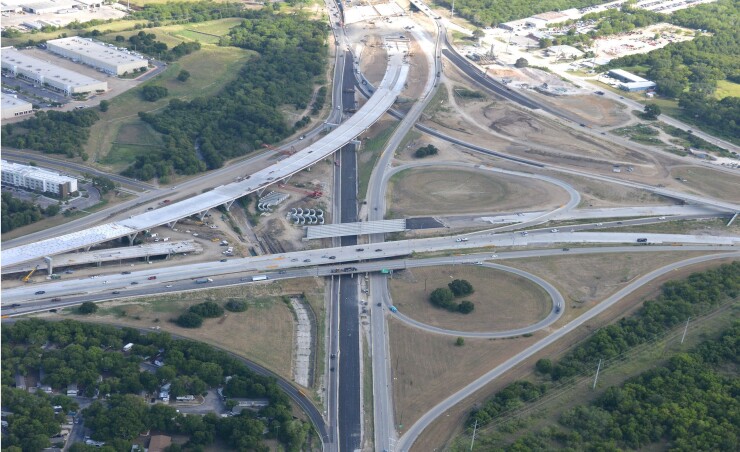Suffering less financial damage from the COVID-19 pandemic than some tollway operators, the Central Texas Regional Mobility Authority goes to market Tuesday with about $333 million of tax-exempt revenue bonds and notes to expand its system.
“COVID-19 negatively impacted 2020 transactions and revenue beginning in March, but a recovery commenced in May that has continued through September,” the authority said in preview of this week’s deal.

The bonds are coming in three tax-exempt series: E, F, and G.
The $163 million Series E bonds mature 2029 through 2050 with 10-year calls and ratings of A-minus from S&P Global Ratings with a negative outlook and Baa1 from Moody’s Investors Service with a stable outlook.
The $111.7 million of Series F revenue bond anticipation notes mature in 2025 with a 2024 par call and ratings of BBB-plus with a negative outlook from S&P and Baa2 with a stable outlook from Moody’s.
The $57.7 million of Series G refund 2015 Series D and E bonds with maturities from 2028 to 2050 with 10-year call provisions and the same ratings as the Series F notes.
“We could revise the outlook to stable in the next two years if activity continues to improve and our expectation of continued traffic recovery allows CTRMA to maintain financial metrics consistent with the current rating and it is sustainable,” S&P analyst Todd Spence noted in his Oct. 19 rating report.
The debt is pricing through senior manager BofA Securities, led by managing director Mitchell Gold.
Richard Ramirez, senior managing director at Hilltop Securities, is financial advisor.
Closing on the deal is scheduled for Nov. 19.
Proceeds of the Series E and F bonds will finance the 183 A Phase III Project and go toward improvements and expansion of other projects.
The CTRMA, created in 2002, owns and operates a toll-road system in the Austin area that includes 183A phase I and II, 290 East, SH 71 East, and SH 45 Southwest, which are all operational, and 183 South and 290E phase III, which are under construction.
“The authority has a record of completing roads to enhance and expand the system,” Spence said. “Having opened to traffic in March 2007, the fully operational 183A toll road was completed on April 6, 2012, on time and within budget.”
The authority completed U.S. 290 East, a 6.2-mile toll road with four direct connectors at the western end of the project, also on schedule and within budget. Toll collections on U.S. 290 began in January 2013 for the interim construction, and on May 17, 2014, for the full project. The 183 South project began tolling of phase 1 in August 2019, with the full project to follow in January 2021.

After this deal, CTRMA will have about $1.3 billion of senior-lien debt and $580 million of subordinate-lien debt outstanding, for a total of about $1.89 billion. At fiscal year-end 2020, unrestricted cash and investments totaled about $121.7 million, equal to approximately 1,172 days' cash and 6.8% liquidity to debt.
After rising sharply in January and February, CTRMA’s revenues fell 5% year-over-year in March before taking a 23% plunge in April. In May, they were only down 2% year-over-year but fell 12% in June before rising up to a negative 2% in July. In August, revenues were down 10% compared to the same month in 2019. In September the drop was 9%.
“As a result of COVID-19 and associated effects, we expect traffic could remain at lower levels for the remainder of fiscal 2021,” Spence wrote. “The traffic and revenue forecast completed in conjunction with the 2020 bonds estimates transactions will be 11.5% lower for calendar 2020, with projected growth in 2021 of 33.6% including the added transactions from the 183S segment.”
CTRMA projects growth rates from 2021-2025 from 12% to 34%, including anticipated transactions due to completed projects. Growth rates in transactions from 2026-2031 range from 2.9% to 4%.
“A slow but steady resumption in traffic growth will help future revenue growth needed to meet escalating debt service requirements that begin to flatten in 2030,” said Moody’s analyst Earl Heffintrayer. “The authority's service area should continue to see above average population and economic growth and benefits from a well-educated work force, high concentration of technology businesses and relatively low costs of doing business.”
Analysts consider an adopted toll policy of annual consumer price index-based toll rate increases a credit strength.
"The rating is constrained by high leverage, primarily related to the doubling of debt associated with the new 183 South Bergstrom Expressway Project (183S) and additional debt through this issuance to fund the 183A Phase III project," Heffintrayer wrote. "While debt service escalates steeply through 2030, traffic and revenue from the new toll roads should materialize ahead of debt service requirements."
As the state capital and home to the University of Texas and other higher education institutions, Austin experiences more stability than other Texas cities, though the region has been hit hard by the coronavirus with cancellation of numerous events and shows, including the annual South by Southwest festival that draws visitors from all over the world.





